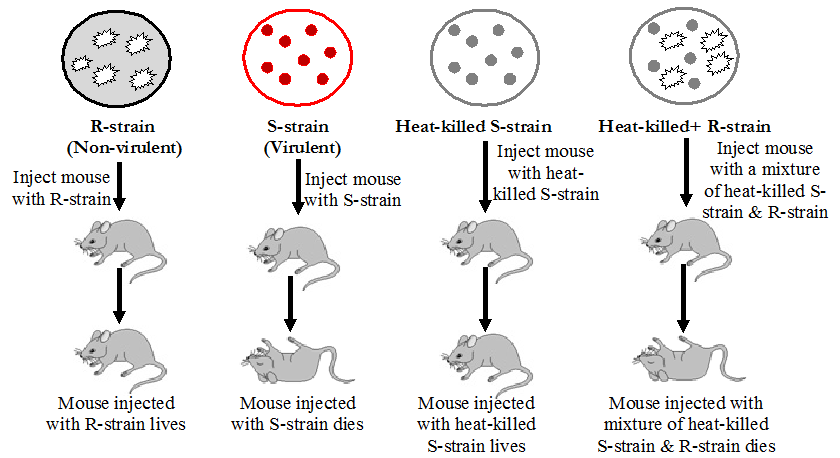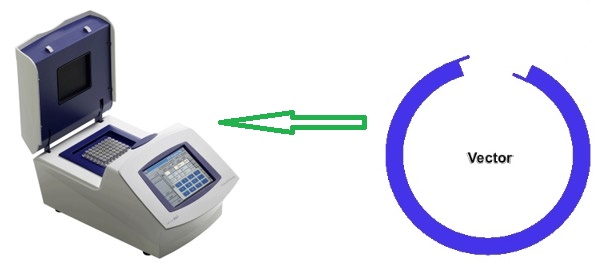Fredrick Griffith showed in 1928 that deoxyribonucleic acid (DNA) is the genetic material of the cell. His work was unique because it was the first evidence that showed that DNA is the genetic material of the cell. Other scientists that also carried out experiments to establish that DNA is the genetic material include Oswald Avery, Martha Chase and Alfred Hershey amongst others. Frederick Griffith was able to transform apathogenic bacteria (i.e. harmless bacteria) to virulent pathogenic bacteria in his transformation experiment.
Gregor Mendel’s work on hereditary to determine the mechanism of genetic inheritance set the stage for the development of the field known as genetics. And scientists over the years have built on these earlier experiments to unravel the genetic code of living organisms as well as manipulate same for other beneficial and economic purposes.
Friedrich Miescher was the first to describe the DNA in 1869, long before Griffith discovered DNA as the main genetic material of the cell. DNA is an integral part of the cell and it is exclusively found in the chromosomes where it is wrapped with histone proteins. The DNA or gene as it is often called encodes gene sequences that coordinate the expression of specific protein molecules in the cell; and they are passed on from parents to their offspring during reproduction.
Frederick Griffith carried out his experiment with mice and Streptococcus pneumoniae (pneumococcus bacteria), the causative agent of pneumonia in humans. And he showed that there was a transforming principle in bacterial genome. Griffith called this transforming principle deoxyribonucleic acid (DNA). He postulated that genetic information could somehow be transferred between different strains of bacteria (particularly amongst pathogenic and non-pathogenic organisms) in a systematic manner; and this could make a non-pathogenic organism to become pathogenic. S. pneumoniae (pneumococcus) occur in two different forms: as virulent strain and as non-virulent strain.
Griffith called the virulent pneumococcus strain S-strain and the non-virulent strain R-strain. The S-strain (virulent strains) of pneumococcus has a smooth polysaccharide capsule that play critical role in the pathogenicity and/or virulence of the bacterium while the R-strain (non-virulent) lacks the polysaccharide capsule. The R-strain has a rough appearance unlike the virulent strain because it lacks the polysaccharide capsule which is present in the later (i.e. the S-strain).
Griffith injected cultures of his rough strain (R-strain) and smooth strain (S-strain) into different groups of mice and allowed them for some days for pathogenicity to take place. He discovered that the mouse injected with the R-strain survived the inoculation while the mouse injected with the S-strain died after a few days (Figure 1). Griffith went on to determine whether the viability of the smooth pneumococcus strain was required for the pathogenicity of the virulent strain.
He wanted to discern whether the factor present in the living smooth pneumococcus bacteria that causes disease (pneumonia) could be transferred to the nonpathogenic rough pneumococcus. To do this, Griffith boiled or heated the virulent S-strain for a short period of time in order to kill the virulent pneumococcus bacteria.
Griffith reasoned whether or not the heated (killed) virulent S. pneumoniae strain could cause disease in the killed state. He injected the heat killed S-strain into the mouse and allowed it for some days. On close observation, Griffith discovered that the mouse survived the inoculation of the heat-killed, smooth pneumococcus strain. Neither the rough pneumococcus bacteria nor the heat-killed smooth pneumococcus bacteria were capable of causing disease on their own; and this could be because they both lack the disease-causing capability which is present only in the smooth pneumococcus bacteria (i.e. the live S-strain).
In another experiment, Griffith inoculated mice with a mixture of the heat-killed virulent pneumococcus bacteria and lives but non-virulent R-strain; and he discovered that the mouse injected with the mixture of heat-killed pneumococcus bacteria and live but non-virulent pneumococcus bacteria survived. Heat denatures protein; and since the mice inoculated with heated-killed S-strain survived the injection, Griffith reasoned that some proteins within the chromosome of the live S-strain could be responsible for causing pneumonia in the mice. Frederick Griffith hypothesized that the live but non-virulent R-strain bacteria had by some means been transformed by the heat-killed S-strain smooth bacteria; and he postulated that some factors may be responsible for transforming the R-strain bacteria into virulent pneumococcus bacteria.
Griffith called the factor responsible for the disease-causing capability in the organism transforming principle, and the process of transformation he called genetic transformation. When pneumococcus bacteria were recovered from the dead mice, Griffith cultured them and found living, smooth pneumococcus bacteria growing on the media. He reasoned that the only way for this to have occurred was if the rough living pneumococcus bacteria (i.e. the R-strain) were transformed to become smooth virulent pneumococcus bacteria. The heating of the S-strain causes rupture on the cell wall of the organism which caused the organism to release its cellular constituents; and some of which were absorbed by the non-pathogenic strain that led to their transformation.

Once inside the cell, the cellular components of the heat-killed bacteria then transformed the living rough bacteria cells into living, smooth bacteria. The exact molecule(s) that make up the transforming factor were not known as at this time. This evidence pointed to DNA as the genetic material even though little was known about the nucleic acids (particularly DNA) as at the time of Griffiths experiment. However, in 1944, Oswald T. Avery and other notable scientists built on the experiments of Frederick Griffith and concluded that the transforming principle responsible for Griffith’s results was deoxyribonucleic acid (Table 1).
Table 1. Summary of the discovery of DNA as the genetic material
| Discoverer | Year of discovery | Findings | Experimental tool |
| Avery T. Oswald (1877-1955) | 1944 | Avery Oswald showed that DNA carries information during transformation; and he discovered the chemical structure of DNA using biochemical techniques. | Protein and nucleic acid degrading enzymes and bacteria |
| Martha C. Chase (1927-2003) | 1952 | Martha Chase, an American geneticist was the only woman amongst men who showed that the genetic material is DNA and not protein. She worked with bacteriophages, and showed that phages inject DNA into bacterial cells when they infect them. | Escherichia coli and a bacteriophage (T2 phage) |
| Alfred D. Hershey (1908-1997) | 1952 | Alfred Hershey showed that bacteriophages inject DNA into bacterial cells; and that when two different strains of phages infect a bacterium, genetic information is exchanged between the two viruses. | Same as above |
| Maclyn J. McCarty (1911-2005) | 1944 | Co-discoverer of molecular structure of DNA with James Watson and Francis Crick. They used structural techniques. In collaboration with Oswald and MacLeod, McCarty discovered that DNA and not protein is the main constituent of the gene. | Same as above |
| Colin M. MacLeod (1909-1972) | 1944 | Co-discoverer of molecular structure of DNA with James Watson and Francis Crick. They used structural techniques. Together with Avery and McCarty, MacLeod discovered that DNA is the actual cellular component responsible for Griffith’s bacterial transformation. | Same as above |
While Frederick Griffith used bacteria (particularly the smooth and rough strains of pneumococcus) to establish the principle of bacterial transformation; the later scientists including Avery Oswald, Alfred Hershey and Martha Chase used viruses i.e. bacteriophages to confirm Griffith’s transformation principle and establish that the genetic material of the cell is deoxyribonucleic acid (DNA).
The work of Frederick Griffith, Avery Oswald and Martha Chase and Alfred Hershey amongst other notable scientists established that DNA is the generic material and an integral part of the genes and chromosomes of living system; and their discoveries laid to rest the earlier claims that the genetic information or material of cells are contained in the cell proteins. Fredrick Griffith’s discovery of DNA as the genetic material was bacteriologically-based, but those of Avery Oswald and colleagues were based on biochemical and structural studies.
References
Alberts B, Bray D, Johnson A, Lewis J, Raff M, Roberts K andWalter P (1998). Essential Cell Biology: An Introduction to the Molecular Biology of the Cell. Third edition. Garland Publishing Inc., New York.
Ausubel, F.M., Brent, R., Kingston, R.E., Moore, D.D., Seidman, J.G., Smith, J.A., Struhl, K., eds (2002). Short Protocols in Molecular Biology, 5th edn. John Wiley & Sons, New York.
Bains W (1998). Biotechnology: From A to Z. 2nd ed. Oxford University Press, New York, USA.
Branden C and Tooze J (1998). Introduction to protein structure. A non-technical introduction to protein structure. New York: Garland Press.
Chen I and Dubnau D (2004). DNA uptake during bacterial transformation. Nat. Rev. Microbiol. 2 (3): 241–249.
Cooper G.M and Hausman R.E (2004). The cell: A Molecular Approach. Third edition. ASM Press.
Dale J (2003). Molecular genetics of bacteria. Jeremy W. Dale and Simon Park (4th eds.). John Wiley & Sons Ltd, West Sussex, UK. Pp. 312-313.
Dale J (2003). Molecular genetics of bacteria. Jeremy W. Dale and Simon Park (4th eds.). John Wiley & Sons Ltd, West Sussex, UK. Pp.
Glick B.R and Pasternak J.J (2003). Molecular Biotechnology: Principles and Applications of Recombinant DNA. ASM Press, Washington DC, USA.
Hames B.D and Rickwood D (1998). Gel Electrophoresis of Proteins: A Practical Approach 3rd Edition. The Practical Approach Series, Oxford University Press
Latha C.D.S and Rao D.B (2007). Microbial Biotechnology. First edition. Discovery Publishing House (DPH), Darya Ganj, New Delhi, India.
Lewis R (2007). Human Genetics: Concepts and Applications. Seventh edition. McGraw-Hill Companies, Inc, New York, USA.
Lodish H, Berk A, Matsudaira P, Kaiser C.A, Kreiger M, Scott M.P, Zipursky S.L and Darnell J (2004). Molecular Cell Biology. Fifth edition. Scientific American Books, Freeman, New York, USA.
Madigan M.T., Martinko J.M., Dunlap P.V and Clark D.P (2009). Brock Biology of Microorganisms, 12th edition. Pearson Benjamin Cummings Inc, USA.
Tamarin Robert H (2002). Principles of Genetics. Seventh edition. Tata McGraw-Hill Publishing Co Ltd, Delhi.
Thieman W.J, Palladamo M.A and Thieman W (2003). Introduction to Biotechnology. Benjamin Cummings, San Francisco, CA.
Discover more from #1 Microbiology Resource Hub
Subscribe to get the latest posts to your email.


